

JAPAN にほん 日本. Japon. Japon. Japonais. Japan. Travel Guide. Discover Japan. Japan-guide.com - Japan Travel and Living Guide. Your Complete Guide To Life In Japan! 10 extraordinarily useful Japanese phrases for travelers. Going to Japan?

Here are some Japanese phrases to memorize on the plane. SOME OF THESE JAPANESE PHRASES are practical. Some of them are funny. All 10 will greatly enhance your trip to Japan. Note that all of the phrases are pretty informal, especially the one about crapping your pants. Confused already? 1. This phrase is absolute magic. If you memorize nothing else before going to Japan, remember “yoroshiku” and you’re totally set. 2. This phrase means something like, “OK, I’m going for it,” or “I’ll do my best.” Japanese people will crack up if you say it before walking outside, eating noodles, or using a vending machine. 3.
The literal translation of this useful phrase is, “Oops! JAPON // JAPAN. Onmark Productions Web Designs & Buddhist Shinto Photo Dictionary of Japanese Deities. The 100 Most Important Japanese Words You Should Know. Itineraries - What to See & Do in Japan. Itineraire. Aokigahara. Aokigahara and Saiko Lake, as viewed from Koyodai in 1995 Aokigahara in 2012 Aokigahara (青木ヶ原?)
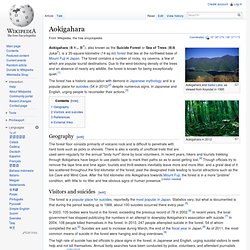
, also known as the Suicide Forest or Sea of Trees (樹海, Jukai?) , is a 35-square-kilometre (14 sq mi) forest that lies at the northwest base of Mount Fuji in Japan. The forest contains a number of rocky, icy caverns, a few of which are popular tourist destinations. The forest has a historic association with demons in Japanese mythology and is a popular place for suicides (54 in 2010)[2] despite numerous signs, in Japanese and English, urging people to reconsider their actions.[3] Geography[edit] The forest floor consists primarily of volcanic rock and is difficult to penetrate with hard tools such as picks or shovels. Visitors and suicides[edit] The forest is a popular place for suicides, reportedly the most popular in Japan.
The high rate of suicide has led officials to place signs in the forest, in Japanese and English, urging suicidal visitors to seek help and not kill themselves. Coordinates: Les meilleures lignes de train panoramiques du Japon / Pen Magazine International. Le train japonais, fierté nationale grâce à ses Shinkansen à grande vitesse, est aussi synonyme d’heures de voyage plaisantes dans un confort optimum ponctué de grandes fenêtres permettant de jouir d’un paysage spectaculaire.
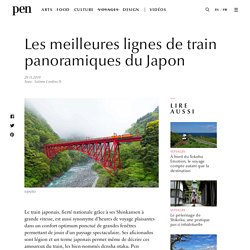
Ses aficionados sont légion et un terme japonais permet même de décrire ces amoureux du train, les bien-nommés densha otaku. Pen Magazine a concocté une liste condensée des plus belles vues du Japon depuis le train. Climbing Or Visiting Mount Fuji From Tokyo. Photos of Kyoto 2 clicks please. Renowned for its blossoming cherry trees, countless shrines and temples, and traditional architecture, Kyoto is one of Japan’s top travel destinations.

Its bountiful beauty has been captured in a seemingly infinite amount of photos, but one picture-perfect snapshot has left the Internet in awe. Captured by photographer Leslie Taylor, the stunning photo of Kyoto presents the city’s undeniable beauty. Recently posted on Reddit, the now-viral photograph depicts a calm, cobblestoned street leading to the famous 5-story Yasaka Pagoda. Silhouetted against the soft pinks, blues, and oranges of the sunset, the landmark looms above the shops and stalls of the historic Higashiyama District—which, as any Kyoto resident can confirm, is normally bustling with tourists and shoppers.
Kyoto Botanical Garden. Kamo-gawa - The Wild Duck River in Kyoto. Add to my favorite places Already visited.

KAMO WAKE-IKAZUCHI JINJA(KAMIGAMO-SHRINE)/English Web Page. Introduction Kamo-wake-ikazuchi-Jinja in the Kita Ward of Kyoto is the oldest Shinto shrine in the ancient city.
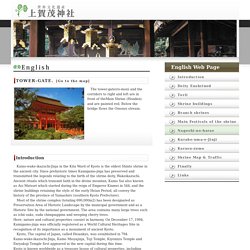
Since prehistoric times Kamigamo-jinja has preserved and transmitted the legends relating to the birth of the shrine deity, Wakeikazuchi. Ancient rituals which transmit faith in the divine mountan, Kamo Sai also known as Aoi Matsuri which started during the reign of Emperor Kinmei in 544, and the shrine buildings retaining the style of the early Heian Period, all convey the history of the province of Yamashiro (southern Kyoto Prefecture). Most of the shrine complex (totaling 690,000m2) has been designated as Preservation Area of Historic Landscape by the municipal government and as a Historic Site by the national government. The area contains many large trees such as ichii oaks, suda chinquappins and weeping cherry trees.
Otagi Nenbutsu-ji - Wikipedia. Otagi Nenbutsu-ji (Japanese: 愛宕念仏寺) is a Buddhist temple in the Arashiyama neighborhood of Kyoto, Japan.
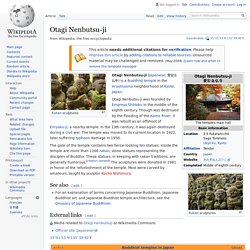
Otagi Nenbutsu-ji was founded by Empress Shōtoku in the middle of the eighth century. Otagi-Nenbutsu-ji temple, Kyoto click 2 x. This small temple is at the north-west corner of Sagano district.

The attraction of the Tendai-shu sect Buddhist temple is a pack of many stone figures. The 1200 Rakan figures were carved by worshipers of this temple from 1981 to 1991 to pray for the prosperity of the temple. Different from usual Buddhist figures, these Rakans seem like having been sculpted with humor and fun. History. A propos de Shikoku|Tourisme à Shikoku. Le côté Pacifique de l’île, qui se compose de la partie située au sud de la chaîne de montagnes de Shikoku qui va d’est en ouest, voit plus que sa part de pluie, mais le climat de l’île entière est relativement chaud.
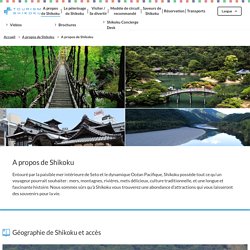
Il y a beaucoup de sites sauvages et naturels, des sites pittoresques et historiques, et des festivals traditionnels. Villages historiques de Shirakawa-gō et Gokayama. La ville de Takaoka : sous le regard du Grand Bouddha, l’art du cuivre à son apogée. À la recherche du troisième Grand Bouddha du Japon L’appellation de « Grand Bouddha », ou daibutsu, rappelle à beaucoup de gens la gigantesque statue du temple Tôdai-ji de Nara ou alors celle de Kamakura, trônant majestueusement en plein air au temple Kôtoku-in.
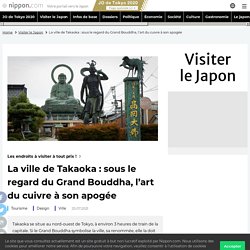
Si elles sont considérées comme les deux Grands Bouddha historiques, les Japonais se cherchent depuis longtemps un troisième daibutsu. Qui sont donc les prétendants au titre ?